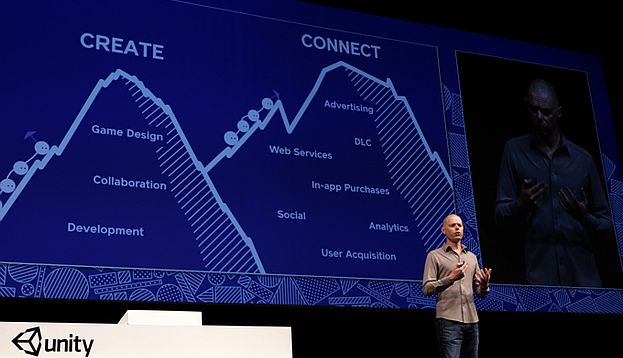At the Game Monetization conference last week in San Francisco, Unity’s vice persident of online services Todd Hooper took the stage to speak about Disruptors and Game Changers in the game industry. More specifically, Hooper addressed why thinking about mobile vs console is wrong-headed, and that it’s really one game industry — albeit with different screen sizes, UI and business models. Hooper’s talk sought to identify the real key disruptors and lessons to be learned in gaming today, and how best to take advantage of those.
The scope of Unity has become vast, and the revolution among indie developers and their increasing prominence owes a lot to the advance of the Unity engine and development environment. The business model Unity employs (free, with a premium version available) has helped spread the engine, as well as the relentless drive of Unity to support every possible platform. Now Unity is looking to provide a range of additional services to developers beyond its game engine, and that’s an important development for the game community.

Hooper started out by sharing some statistics revealing just how strong Unity has become, and that the number of Unity developers means that some very useful data is available to Unity. In 2011 Hooper noted that Unity had some 100,000 developers, and that’s not the number registered, but the number who actually would launch the software at least once a month and use it. That number is an impressive one, but in three years it’s grown to an astonishing 639,000 monthly active Unity users.
Hooper also noted that 45 percent of mobile games made with third party engines are made with Unity, and the company has seen 500 million desktop games installed that have been built with Unity. That’s an impressive number, but it pales compared to the number of mobile games made with Unity that have been installed: 8.7 billion mobile games worldwide so far. That’s not even all of them, as Hooper noted some big publishers don’t share their numbers with Unity, so the actual number is probably well above 10 billion games installed worldwide.
Hooper, knowing that the majority of Unity’s developers are small shops, mad an important analogy. He likened game development to mountain climbing, where game developers bring together talented people and put forth great effort to create a game. They reach the top of that mountain and feel triumph, but looking out ahead there’s another, even bigger mountain to climb: Connecting with an audience. Hooper noted that “Most developers don’t know how to tackle the second mountain” and Unity intends to help them with that task.
This is why, Hooper explained, Unity purchased game analytics firm Playnomics earlier this year. The company had created an effective set of analytics tools for developers, and Unity’s intent is to bring that to its large development community. “What’s the number one analytics tool used by mobile game developers ” Hooper asked the audience. “We surveyed our developers, and the answer was: No analytics. We mean to change that.”
Hooper shared with the audience some of the statistics gathered from Unity’s immense audience. Android is number one in most markets, of course, but the lead differs between countries. And while there are over 3000 different types of Android devices out there, the number that are asignificant part of the market are quite small. Hooper noted that some brands that may be unfamiliar to US marketers, like Huawei and Xiaomi in China, actually have quite large market shares in that country.
By contrast, the iOS market is much similar, with far fewer models and much less variation in the operating system version. The market is roughly split between iPads and iPhones, at least as far as Unity games are concerned. The big difference with Android users is that iOS users generally upgrade to the latest version of the operating system relatively swiftly. By contrast, less than 1% of the Android market has the very latest version of the operating system installed.
One of the key facts about mobile games is that less than 1 percent pay to play globally, Hooper pointed out. The median spend is $4.99 for men, but only $3.13 for women. The churn rate (the average time before a customer stops playing a game) is vast among mobile games, no doubt due to the free nature of most of the games. Looking at thirty days after download, 89 percent of iOS users fail to return, while 97 percent of Android users drop out. In U.S., Hooper said, seven to nine days is the average churn time, while in most other places in the world it’s two to three days. The total spend for iOS games (among those players who have paid) is $93.77, while Android is $75.27 — compared to web games at $19.13, that’s quite impressive.
Hooper explained that Unity’s plan is to offer analytics as part of its development suite for no cost, attempting to bring as many developers as possible into the world of using analytics to help create better games — and make more money. “Analytics will be turned on in every Unity game by default,” Hooper said, with the intent that this will create widespread knowledge of analytics and usage thereof. Although not every developer may want this, and “You’ll be able to opt out,” Hooper said. Hooper acknowledged that there are plenty of commercial analytics packages, and Unity’s intent is not to supplant those.

“It’s pretty tough to take that data back to a producer and get changes made,” Hooper acknowledged. In most cases, especially when you don’t know the right questions to ask, “The info is not specific enough for developers to take action on it,” Hooper said. Unity is working to provide some of the standard information that most analytics packages provide, but adding a special feature: benchmarking. “This lets you see where you are versus the average game,” Hooper said. “Here is exactly how you can improve your game” Hooper said, showing a screen displaying the difference between the revenue an average game makes after seven days with the results for one particular games.
This ability to direct a developer’s attention to the exact part of the game that needs attention is a critical feature that Hooper believes will be of great value. More than that, though, their tool will recommend which demographic segments to advertise to, ones that are unlikely to monetize.
We should see a bright future for analytics as Unity brings that to hundreds of thousands of developers who aren’t currently using analytics to improve their games. This should help analytics firms generate more business, too, as more developers understand exactly what analytics can do for them and how specific capabilities offered by a vendor can benefit the developer.
One thing is clear: Unity won’t stop looking for ways to help developers make money from games. This will be an interesting space to keep an eye on in the future.

